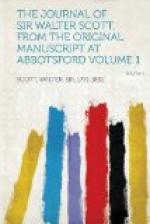See also Lane’s Egyptians for an account of what appears to be the same man in 1837. Also Quarterly Review, No. 117, pp. 196-208, for an examination of this “Magic Mirror” exhibition.
[474] A hoard of seventy-eight chessmen found in the island of Lewis in 1831. The greater number of the figures were purchased for the British Museum, and formed the subject of a learned dissertation by Sir Frederick Madden; see Archaeologia, xxiv. Eleven of these very interesting pieces fell into the hands of Scott’s friend, C.K. Sharpe, and afterwards of Lord Londesborough. More recently these identical pieces were purchased for the Museum of Antiquities, Edinburgh, where they now are. See Proc. Soc. Antiq., vol. xxiii.
[475] Sir John Malcolm, who was at this time M.P. for Launceston. His last public appearance was in London, at a meeting convened for the purpose of raising a monument of his friend Sir Walter, and his concluding words were, that when he himself “was gone, his son might be proud to say that his father had been among the contributors to that shrine of genius.” Sir John was struck down by paralysis on the following day, and died in May 1833.
[476] The celebrated Brahmin philosopher and theist; born in Bengal about 1774, died at Stapleton Grove, near Bristol, September 27, 1833.
[477] Sir Walter’s fears for the country were also shared by some of the wisest men in it. The Duke of Wellington, it is well known, was most desponding, and he anticipated greater horror from a convulsion here than in any other European nation.
Talleyrand said to the Duke during the Reform Bill troubles, “Duke of Wellington, you have seen a great deal of the world. Can you point out to me any one place in Europe where an old man could go to and be quite sure of being safe and dying in peace?”—Stanhope Notes, p. 224.
[478] See Mr. Charles Cowan’s privately printed Reminiscences for Scott’s recollections of his visit to Portsmouth in 1816, and his stories, of the wonders he had seen, to the little boy at his side.
[479] Compare Froude’s History, vol. iv. p. 424.
[480] Mr. Horace Smith, one of the authors of Rejected Addresses.




